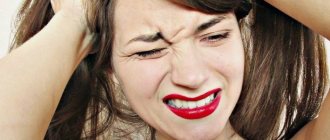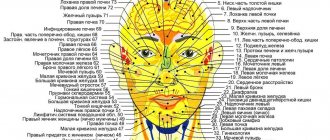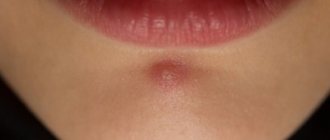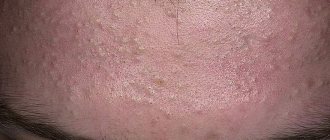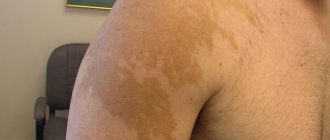Sometimes even the most well-groomed women with flawless skin develop unpleasant pimples, and they occur more often on the chin than on other parts of the face. Such pimples cause discomfort and spoil the overall aesthetic appearance of the face. Masking them with foundation is not a solution; it only aggravates the problem.
Often women fight them exclusively by external means, but it is important to understand that the appearance of such a skin defect may indicate serious disorders in the body. After all, rashes on the skin indicate the state of a person’s health and tell them what to pay attention to.
In this article we will look at the factors that influence their appearance in the lower area of the face, and you will also learn how to resist their onslaught with the help of modern and traditional medicine.
Why do acne appear on the chin in women?
Representatives of the fair sex are more susceptible to various rashes than men. Most often this happens under the influence of hormonal levels, during menstruation and pregnancy, as well as due to improper facial skin care. Based on the location where the pimple appears, you can also tell what kind of problem activated this process. That is why, if acne appears on the chin of women, then the following reasons for their occurrence can be identified:
- Hormonal disbalance.
- Errors in nutrition, a lot of fatty and sweet foods.
- Weakening of the immune system.
- Improper facial hygiene.
- The bad habit of propping your head up with your hands, scratching and squeezing out pimples on your chin.
- High collars and thick scarves can also irritate this area.
- Stressful situations.
- Hereditary predisposition.
- Diseases of the digestive system.
- Poor environment and harmful working conditions.
It is believed that acne on the chin in women appears due to problems with the ovaries and the reproductive system as a whole. That is why, disruptions of the menstrual cycle, problems with conception and the onset of menopause can give a “signal” with rashes on the chin.
In girls with combination skin, this can also be caused by incorrectly selected care products. The fact is that with possible dryness of the cheekbones and skin around the eyes, in the so-called T-shaped area, the activity of the sebaceous glands is significantly increased. That is why you should cleanse and moisturize your forehead, nose and chin more thoroughly, and use more gentle formulations and nourishing creams on the rest of the face.
Main types
There are several types of painful acne on the chin, in particular, such as:
- red rashes;
- large seals;
- small white subcutaneous pimples.
A red rash indicates an allergy or dermatitis. A cluster of small bumps forms on the skin. Large painful lumps on the skin can be in the form of a carbuncle or boil. This is an inflammatory process that affects one follicle. The size of acne can be 2 cm and manifests itself as severe pain. If it is detected, the help of a dermatologist is required.
A carbuncle is an inflammation that involves several follicles, which means that the infection can cover an even larger area. It is very dangerous to neglect them, as the disease can develop into a cyst, which requires surgical intervention.
Small internal white subcutaneous painful pimples on the chin are accumulated subcutaneous fat in which bacteria develop and nodules form.
Types of acne on the chin
The nature of the rash can also determine a possible problem. This is a very important stage in choosing the “right” tactics to combat acne, because some varieties are almost impossible to cope with at home.
Types of chin rashes in women:
- Subcutaneous acne . The most common type of rash occurs due to a blocked sebaceous gland. When an infection gets inside, an inflammatory process develops. Such a pimple will “ripen” for a long time, but when squeezed out, the infection can penetrate into the deep tissues of the skin and cause additional problems.
- Black dots . A type of open blackhead in which the sebaceous plug at the top oxidizes and appears as a black mark. After squeezing, a similar pimple forms on the spot, so comprehensive care is required here.
- White eel . If the pore does not have an open “exit,” the rash looks like a white speck. After squeezing or scratching, an inflammatory process can also develop, but usually such rashes are the least problematic.
- Purulent pimple . Develops as a consequence of a skin infection or decreased immunity. Usually very numerous and require special treatment with antibacterial agents. Most often they are localized in the T-shaped area, less often on the chin.
- Acne . Numerous grooves, manifested by severe inflammation and leaving behind bumpy, pigmented skin. The location can be anywhere, most often the forehead and chin are affected. The reason is hormonal imbalance, hereditary factors and nutritional errors. Acne treatment is best done together with a dermatologist.
- Herpes rashes . In some cases, the rash may appear not only on the lips, but on the nose and chin. Herpes rashes are small with a watery head. Under no circumstances should they be squeezed or scratched - this can lead to the spread of infection and marks at the site of the rash. It is best to use special ointments that will remove the rash in a few days.
Depending on the types of acne, the methods for eliminating them differ. At home, the easiest way is to use antiseptic compounds that will dry and eliminate inflammation. If acne is permanently “registered” on the chin or the rash appears regularly, it is best to seek professional help or use special cosmetics and medicinal products.
Diagnostics
If signs of subcutaneous acne appear or if there are a large number of them, you should contact a dermatologist. The doctor will conduct an external examination and order laboratory tests of blood, urine and feces to determine the presence and type of infection or virus. A scraping may also be taken from the surface of the skin to identify the presence of subcutaneous mites.
To determine the cause of the appearance of purulent formations, consultation with other specialists is required, for example, a gastroenterologist, neurologist, endocrinologist. After identifying the disease that caused acne, complex therapy is prescribed. First of all, it is necessary to eliminate the cause itself. After this, subcutaneous acne is treated.
How to get rid
Treatment methods vary, but numerous acne and purulent rashes are best treated under the supervision of a good dermatologist. In this case, you may need to take hormonal medications or antibacterial agents, which are very risky to use without a doctor’s prescription. The following methods have proven effective at home:
- Inexpensive pharmacy ointments will help speed up the maturation and draw out the purulent contents of large inflammatory pimples. This can be birch tar, Vishnevsky ointment based on it, or ichthyol. After wiping the surface with a disinfectant solution (alcohol or peroxide), squeeze a little ointment onto sterile cotton wool and stick it to the chin with a band-aid. It is advisable to do this procedure at night, and by the morning the intensity of inflammation will noticeably decrease. A couple of these compresses and the pimple will go away without a trace.
- Proper cleansing of the face is the key to successfully combating rashes. To do this, it is advisable to use a suitable cosmetic product (lotion, micellar water, tonic), foams and mousses for washing. You should not go to bed with traces of decorative cosmetics, because clogged pores and the inability of cellular respiration will lead to new acne.
- Folk remedies will also come in handy. In areas of inflammation, you can use compresses from fresh aloe juice, as well as bee honey (if you are not allergic to it). Regular washing with decoctions of medicinal herbs (chamomile, sage, nettle, infusion of birch buds), as well as brewing simple green tea, have a very beneficial effect on skin health.
- Anti-inflammatory drugs. Many cosmetic brands have similar products in their lineup. Nivea and Garnier brand products have proven themselves well. You can use special pharmaceutical preparations such as “Zinerit” and “Clerasil”.
- If the appearance of acne is caused by a poor environmental situation in the place where you live or a digestive problem, you can use detoxifying drugs. This can be activated carbon, Enterosgel and Polysorb.
- Homemade, purchased clay-based masks help dry the skin well and regulate sebum production.
If you regularly experience subcutaneous acne on your chin, you should definitely go to a gynecologist and check your health. Hormonal imbalance is corrected by taking oral contraceptives, but if there is a lack or excess production of certain hormones, examination by an endocrinologist may be necessary. Also, some gastrointestinal diseases can manifest as rashes on the face. In any case, acne on the chin does not appear just like that; for effective elimination, it is important to find the root cause.
Treatment methods
When subcutaneous acne appears, the patient needs to follow a special diet, take certain medications and maintain hygiene. In case of large lesions of the skin area and severe pain, it is recommended to carry out facial cleansing in beauty salons or medical institutions.
Diet
The main cause of subcutaneous acne is an unbalanced diet, when a person consumes large quantities of fast food, sweets and fatty foods.
In order for the treatment to be effective and metabolic processes to be restored, it is necessary to eat properly. The diet should include fruits and vegetables, berries, and dairy products. Coffee, eggs, sweets and smoking have a negative effect on the skin.
Drug treatment
To clear the skin of acne, a number of medications are prescribed. They have different forms of release and help to influence the cause not only externally, but also internally.
For external use:
- Antimicrobial drugs, for example, Baziron AS. It contains antiseptic agents and helps fight acne on the chin.
- Preparations based on azelaic acid. Skinoren belongs to this group. The acid contained in the product prevents the skin pores from closing.
- "Differin." A product that contains substances that slow down the process of cell division.
- "Dalacin gel". Dries out acne and has an antibacterial effect. Also helps relieve inflammation. The drug is applied twice a day for 6 days. It is used only as prescribed by a doctor, as it contains a strong antibiotic.
- "Curiosin gel" . Indicated for oily skin. Apply the drug to acne twice a day.
- "Ichthyol ointment." Prescribed in the presence of a large number of purulent masses.
- "Vishnevsky ointment". A popular remedy that has anti-inflammatory, healing and antiseptic properties. Apply directly to acne.
On this topic
- Pimples
5 ways to get rid of acne right now
- Inna Viktorovna Zhikhoreva
- March 29, 2020
The following groups of drugs are prescribed for internal use:
- Antibiotics. Used only as prescribed by a doctor after the type of infection has been determined. Not every antibiotic can have a positive effect, since different types of pathogenic microorganisms have different degrees of susceptibility to the active components. But you need to take the drug with caution, as side effects include dysbiosis, thrush and allergies. If there are a large number of acne on the chin, Doxycycline is most often prescribed.
- Hormonal agents. They are prescribed to women in cases where the appearance of rashes is caused by hormonal disorders.
- Retinoids. They cope well with subcutaneous acne, but have a number of disadvantages in the form of side effects. Among them are dry skin, central nervous system disorder, changes in motor activity and disruption of the pancreas. That is why drugs in this group are prescribed in rare cases when other drugs do not have the desired effect.
On this topic
- Pimples
How to quickly get rid of acne on the chin
- Inna Viktorovna Zhikhoreva
- September 27, 2020
Treatment of subcutaneous acne should be carried out under the supervision of a physician. Self-medication can lead to serious consequences.
The use of traditional methods of treatment should be agreed with the attending physician, since many recipes contain components that can cause allergies. Improper therapy leads to the spread of purulent masses and inflammation. Over time, acne affects large areas of the skin.
Hygiene
Hygiene procedures play an important role in the treatment of acne. Skin care should consist of several stages:
- Cleansing procedures. For this, soap and special scrubs are used.
- Moisturizing stage Necessary to prevent overdrying of the skin.
- Mitigation.
To avoid clogging the ducts of the sebaceous glands, it is necessary to avoid using foundation creams. They create a film that does not allow air to pass through and clogs pores.
Instead of leveling agents, it is recommended to use moisturizer and loose powder. They will protect the skin from the effects of negative external factors.
Face cleaning
To quickly get rid of acne on your chin, you can go to a beauty salon for a special skin cleansing procedure. Modern cosmetology can offer a number of different techniques:
- Peeling. The procedure is very popular. Special concentrated acids are used for cleaning. Peeling has a number of contraindications and you should consult a doctor before performing the procedure.
- Mechanical peeling. Aluminum salts are used for purification.
- Laser cleansing. One of the most modern ways to cleanse pores and remove acne. The essence of the method is the effect of a laser, which delivers oxygen to the cells. The skin acquires a natural color, is evened out, and formations do not appear for a long time.
What not to do for acne on the chin
For effective treatment, it is worth defining a list of prohibitions that should be strictly followed. Most often, we perform these actions automatically, without thinking about the consequences.
Factors that aggravate the problem:
- Self-squeezing and scratching pimples.
- The habit of constantly touching your face with your hands.
- Use of cosmetics that are not suitable in composition.
- Insufficient cleansing or excessive sterility, leading to the removal of the protective film on the skin.
Scrubs and peels should not be used at the site of the rash, as they will damage the skin and lead to the spread of infection. Even professional cosmetic procedures should not be done if the skin is inflammatory. Manual and mechanical cleaning, laser resurfacing, ozone therapy and other achievements of modern cosmetology are carried out after eliminating inflammatory processes.
What Causes Acne
Blackheads and whiteheads are the same thing.
Both are a type of “comedone” and form when dead skin cells, oil and dirt clog skin pores. A clogged pore that remains open at the top is known as a blackhead, whereas a pore that is completely closed is called a whitehead or closed comedones. Blackheads are black in color because the top of the pore is left open and exposed to air, which leads to the oxidation process and consequently the black color. Typically, whiteheads are not inflamed and cause pain and redness in the skin, but if bacteria gets into the comedone, it can become infected and inflamed and turn into pustules, which are an inflamed red bump filled with yellow pus and a white head on top.
Cosmetologist's advice
Preventing skin rashes is equally important. To do this, it is worth paying attention to this problem, once and for all finding a suitable skin care algorithm. To prevent acne from appearing, it is important to take a comprehensive approach to prevention, so it is worth listening to the advice of professional cosmetologists.
Important points to prevent rashes on the chin:
- Select only high-quality cosmetics that suit your skin type.
- Be sure to cleanse and moisturize your skin daily. In winter, it is advisable to use additional nutrients.
- Adjust your diet. “Harmful” products with preservatives, caffeine and other chemical additives can aggravate the problem.
- Timely treatment of chronic diseases and taking care of your health.
- Taking complex vitamins during the off-season will help strengthen your immune system.
Careful skin care will preserve a woman’s natural beauty for a long time. It’s very disappointing when the entire result is spoiled by pimples and blackheads on the chin, so you should definitely determine the possible cause and eliminate it.
Preventing rashes
The following measures are suggested to prevent acne:
- Careful selection of facial cosmetics, it should suit your skin type and solve existing problems.
- Compliance with healthy eating rules.
- If sebum secretion increases, use antibacterial agents as care.
- After the skin has healed, periodically consult with highly specialized specialists to prevent relapse (endocrinologist, dermatologist, cosmetologist).
Don't waste your time panicking when acne appears on your chin. All attention should be concentrated on eliminating cosmetic and sometimes medical problems

